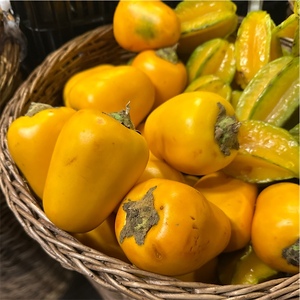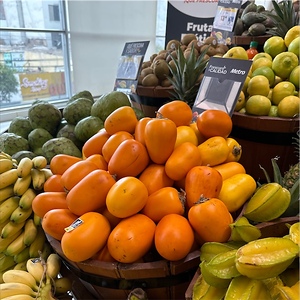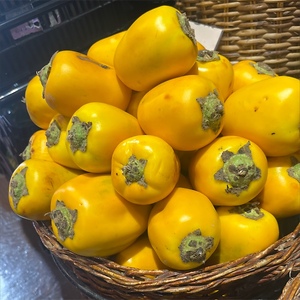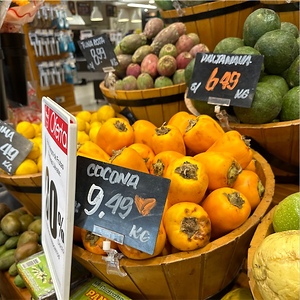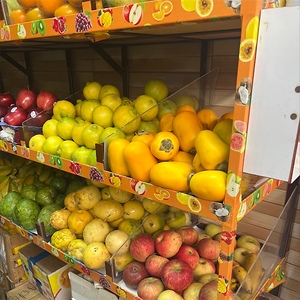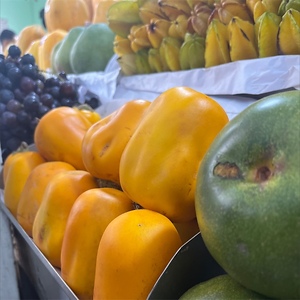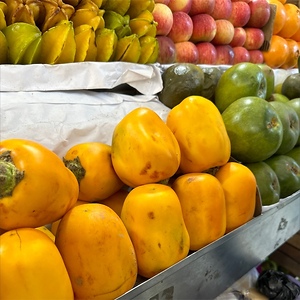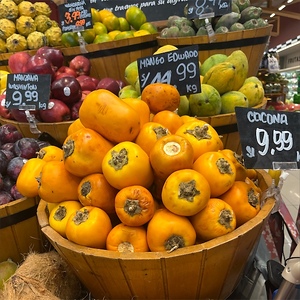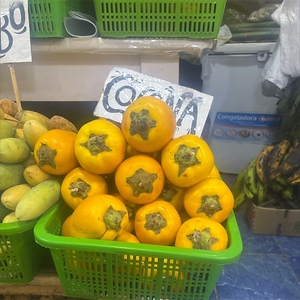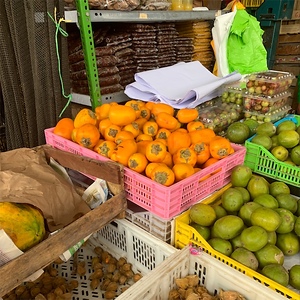

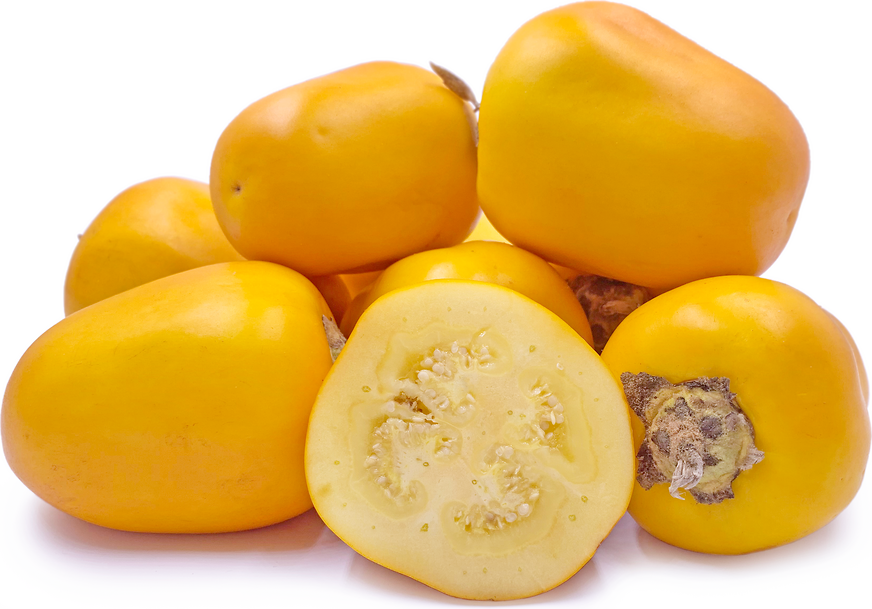
Cocona
Estimated Inventory, lb : 0
Description/Taste
Cocona varies in size, depending on growing conditions and age at harvest, and generally averages 2 to 10 centimeters in length and 4 to 8 centimeters in diameter. The fruits have an oblong to oval shape with blunt, curved ends, and some note that they sometimes take on a blocky, bell-pepper-like shape. The fruit’s skin is thin, taut, and tough, initially green and coated with a spiky, prickly fuzz when young, maturing to golden orange, red, or purple-red, depending on the variety. When the fruits reach maturity, they lose their fuzz and develop a smooth and glossy appearance, wrinkling slightly. Underneath the surface, the flesh ranges in color from pale yellow to cream-colored and is firm, dense, and aromatic, encasing chambers filled with many tiny, flat, and oval seeds. Cocona fruits have a faintly herbal, savory, tomato-like aroma and are crunchy, aqueous, and succulent. The flesh has an acidic, sour, and tart taste with subtle fruity and vegetal
Seasons/Availability
Cocona fruits are available in the fall through winter.
Current Facts
Cocona, botanically classified as Solanum sessiliflorum, are tropical fruits that grow on herbaceous shrubs in the Amazon belonging to the Solanaceae family. The sweet-tart fruits are a distant relative of the tomato and eggplant and are closely related to another Andean fruit, the naranjilla, also known as lulo. Cocona fruits are often mistaken for naranjillas as many growers use the two different species names interchangeably when selling the fruits in local markets. The two species have also been naturally crossed, developing hybrids, causing the identification of the fruits to be more challenging. There are many different varieties of Cocona fruits found throughout South America, varying in appearance and flavor, and the fruits are also known as Topiro, Tupiru, and Orinoco apples by the native peoples of the upper Orinoco River, and as Cubiyú in the city of Manaus, Brazil. Cocona fruits are primarily localized to their native regions and are not well-known outside of South America. Within the Amazon, the fruits are widely consumed, especially in Peru, for medicinal and culinary purposes.
Nutritional Value
Cocona fruits are an excellent source of vitamins A and C, antioxidants that strengthen the immune system, boost collagen production within the skin, and reduce inflammation. The fruits are also a good source of iron to help carry oxygen through the blood to vital organs, fiber to regulate the digestive tract, and provide smaller amounts of phosphorus and calcium. In traditional medicines of indigenous peoples, Cocona fruits were used as a natural diuretic and were used topically in powder and paste form as an insect repellent, wound treatment, and eczema relief.
Applications
Cocona fruits are best suited for both raw and cooked applications. When fresh, the fruits can be peeled and consumed as a snack, or they are popularly juiced and mixed with sugar and other fruits to create sweet-tart beverages. The peeled flesh can also be sliced and tossed into salads or blended into a spicy condiment known as Cocona uchu, made with ojo de pez peppers or local aji charapita peppers. The hot chile peppers add citrus-forward notes to the tart, tropical Cocona creating a sweet, fruity, and spicy condiment. In addition to fresh preparations, Cocona fruits can be cooked into jams, jellies, and sweet fillings for cakes, tarts, pies, and muffins, or blended into ice cream. They can also be cooked into sauces for roasted meats, tossed into stews and soups, or pickled and candied for extended use. Cocona fruits pair well with fruits such as mango, passionfruit, and soursop, herbs such as cilantro, parsley, and huacatay, chile peppers, potatoes, and meats such as poultry, beef, and fish. Whole, unopened Cocona fruits will keep up to one week, depending on the degree of ripeness, when stored in the refrigerator.
Ethnic/Cultural Info
Cocona fruits are traditionally consumed on June 24th during the Festival de San Juan in the Peruvian Amazon. The annual celebration honors Saint John the Baptist, the guardian over the rivers and waters of the Amazon, and is a day where family and friends gather at the rivers to cleanse themselves for good luck. While residing by the rivers, local foods are consumed, including the most famous dish known as juanes, which is a mixture of seasoned rice, meats, olives, and eggs wrapped in bijao leaves. Juanes are rumored to have been named for their resemblance to Saint John’s head when it was served on a platter after his beheading. Cocona fruits are popularly chopped into salsas and are served with juanes. The fruits are also peeled and consumed fresh, as festival participants bathe in the rivers, play live music, and dance in honor of the Saint.
Geography/History
Cocona fruits are native to the western Amazon rainforest, a region that spans across parts of Brazil, Peru, Ecuador, Columbia, and Venezuela. The ancient fruits have been growing wild for thousands of years and were first cultivated by indigenous tribes of the region. In 1760, Cocona fruits were officially documented in home gardens located in the area of Guaharibos Falls by Spanish colonists, and the fruits have been studied through local research stations in Peru throughout the 19th and 20th centuries. Today Cocona fruits are primarily localized to their native habitat of the Amazon jungle and are found at jungle markets in Peru, Brazil, Colombia, and Venezuela.
Recipe Ideas
Recipes that include Cocona. One



